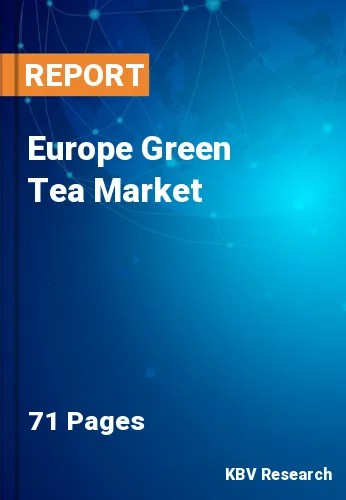The Europe Green Tea Market would witness market growth of 7.9% CAGR during the forecast period (2022-2028).
Green tea is processed and cultivated in a variety of ways, based on the specific variety. As a result of these techniques, the maximum number of polyphenols and volatile organic compounds, which affect scent and flavor, are kept. There are two fundamental sorts of growing conditions viz. those grown in the sun and those produced in the shade. The green tea plants are typically harvested three times each year and are planted in rows that are regularly pruned to create buds.
The initial flush occurs between late April and early May. The second harvest typically occurs from June to July, while the third harvest occurs from late July to early August. The first flush of spring produces the highest-quality leaves. After harvesting, green tea is processed using either artisanal or sophisticated techniques. Typical artisanal techniques include sun-drying, basket or coal firing, and pan-firing. Oven drying, tumbling, and steaming are typical contemporary techniques. The processed green teas, known as aracha, are stored in 30- or 60-kilogram paper bags at 0–5 °C and low humidity.
This aracha has not yet been refined as the last firing must occur before blending, selection, and packaging can occur. The leaves will be re-fired as needed throughout the year, providing the green teas with a longer shelf life and enhanced flavor. In this manner, the first flush tea of May would keep well until the following year's harvest. After re-drying, each crude tea will be sieved and sized according to its particle size. Each lot will then be blended in accordance with the blending sequence and packaged for sale by the tasters.
This region has an unusually high prevalence of diabetes. Diabetes is a cause of a number of other chronic illnesses, and because it lowers the patient's immune system, it makes it challenging to diagnose other ailments. According to the European regional office of the World Health Organization, 60 million individuals suffer from diabetes. In addition, 10.3% of male patients and 9.9% of female patients were at least 25 years old. This is a significant amount that requires regulation. In addition, the increasing popularity of probiotic supplements within this region would increase the market for green tea in this region.
The Germany market dominated the Europe Green Tea Market by Country in 2021; thereby, achieving a market value of $1,595.6 million by 2028. The UK market is anticipated to grow at a CAGR of 7.1% during (2022 - 2028). Additionally, The France market would witness a CAGR of 8.7% during (2022 - 2028).
Based on Form, the market is segmented into Green Tea Bags, Instant Green Tea Mixes, and Loose Green Tea Leaves. Based on Type, the market is segmented into Flavoured and Unflavoured. Based on Distribution Channel, the market is segmented into Supermarket/Hypermarket, Convenience Stores/Specialty Stores, and Online. Based on countries, the market is segmented into Germany, UK, France, Russia, Spain, Italy, and Rest of Europe.
Free Valuable Insights: The Global Green Tea Market will Hit $22.8 Billion by 2028, at a CAGR of 8.1%
The market research report covers the analysis of key stake holders of the market. Key companies profiled in the report include Unilever PLC (Tazo Tea), Associated British Foods PLC (Wittington Investments Limited), Tata Consumer Products Limited (Tata Group), East West Tea Company LLC (Yogi Tea), Typhoo Tea Limited (Zetland Capital), Bigelow Tea, Numi Organic Tea and Northern Tea Merchants Ltd.
By Form
By Type
By Distribution Channel
By Country
Our team of dedicated experts can provide you with attractive expansion opportunities for your business.

